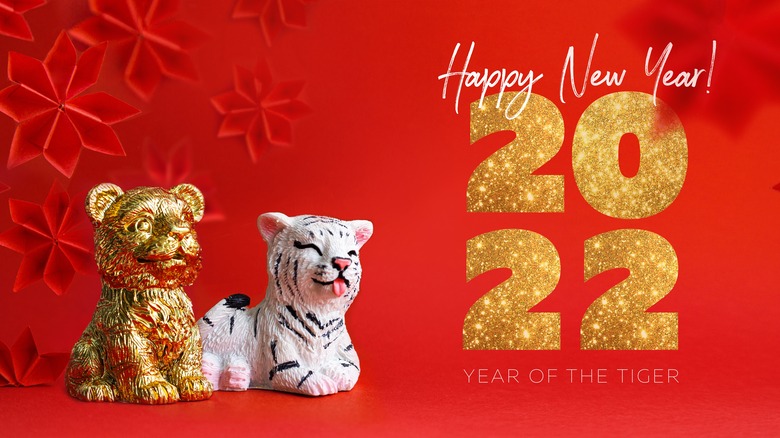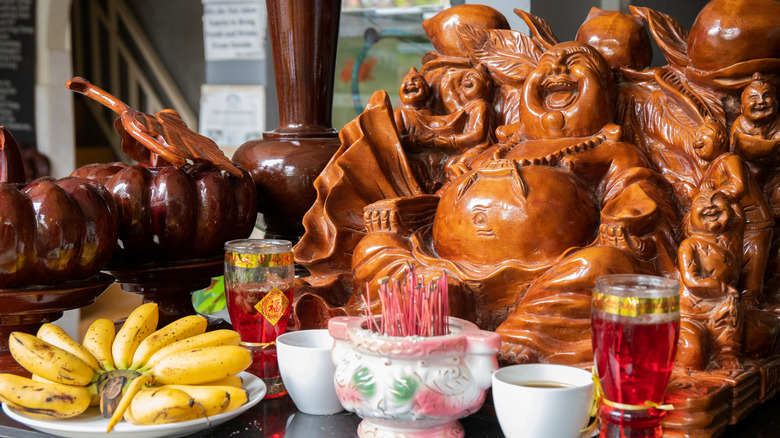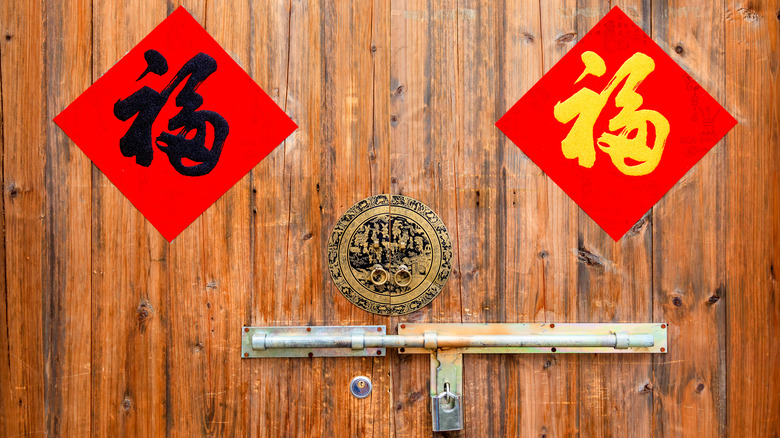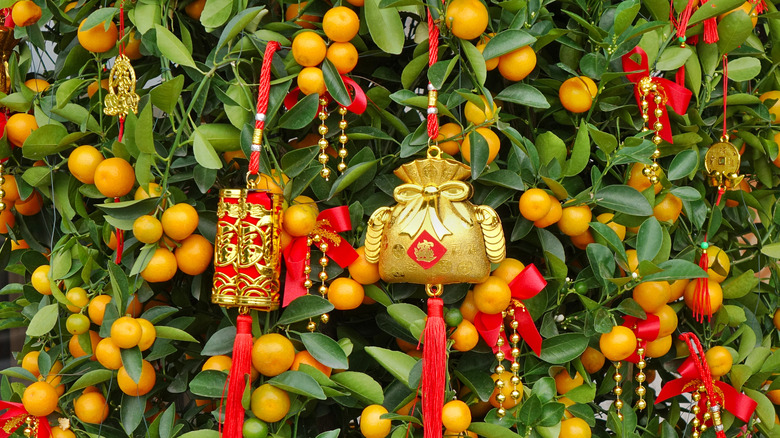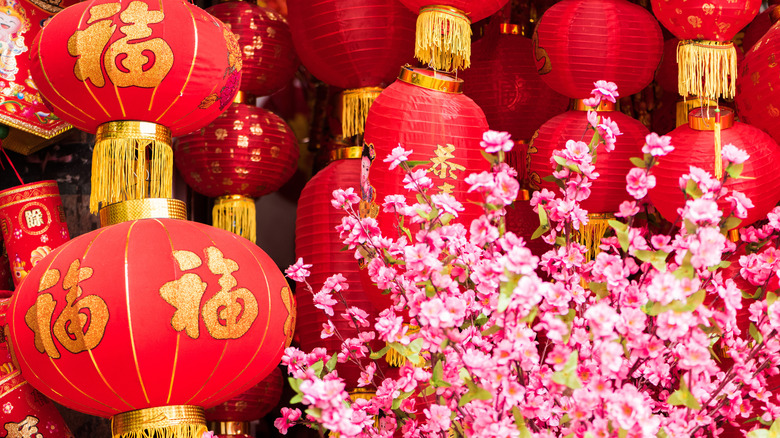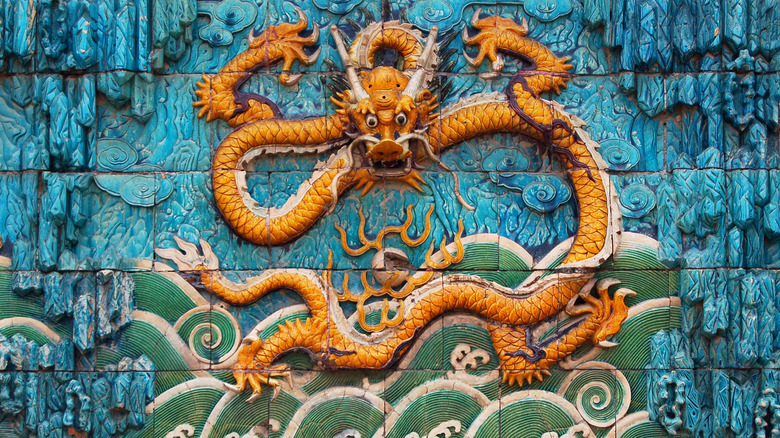How To Decorate Your Home For The Lunar New Year
Ready to discover how to decorate your home for the lunar new year in a traditional-yet-modern Chinese style that'll have the neighbors peeping jealously? The Chinese new year — dating as far back as 3,500 years (via The Holiday Spot) — marks China's victory over the mythical beast Nian, which notoriously ate and destroyed crops, livestock, and humans every New Year's Eve (not anymore, thank God).
While the ancient celebration style of the Chinese new year has changed over the years, the lighting of fireworks and the display of the color red in various shades (both responsible for the great victory) remain the main hallmarks. As explained by Culture Trip, some of the festive lunar new year activities also include eating Chinese food until you can barely walk, engaging in lion dances, and exchanging money gifts.
To usher in the tradition's goodness, people who celebrate the lunar new year must wrap it up with the famous lantern festival, as explained by China Travel. Also, Travel China Guide lists some of the Chinese new year taboos you should avoid. Spoilers: Thou shall not cook or eat porridge, cry, wash your hair, dress in black or white, or take afternoon naps. So, when is Chinese new year 2022? Well, according to Chinese New Year, 2022 is the year of the tiger and is to start on February 1st and end on February 11th. Read on discover how to decorate your home for the lunar new year creatively.
Set up a DIY Vietnam-style Bàn Thờ shrine
Temple visits are part of the lunar new year celebration, but religious activities can be done at home in a DIY Bàn Thờ fashion. As written by IMB, the worships start with appeasing the kitchen god (Zao Shen) with rice cakes (Nian Gao) seven days before the new year for the atonement of sins. Other worship activities include indoor Cúng Giao Thừa (welcoming the spirit of ancestors indoors) and outdoor Cúng Giao Thừa (sending prayers to the dead).
To set up a DIY Vietnam-style Bàn Thờ shrine, Trami Nguyen Cron of Chopsticks Alley explains, arrange 3 cups of rice wine, tea, or spring flowers (preferably peach blossom), and two candles. Also, display pairs of five types of new year's fruits and lunar new year decorations. Additionally, you should make Bánh Chưng and put them outside the shrine to feed your ancestors. Finally, light incense and eat homemade steamed pork patties, boiled chicken, and soup once the incense go out.
Mind you, your Bàn Thờ shrine doesn't have to be 100% Vietnamese style. You know ... get creative, and add a modern touch with balloons, lucky charms, a well-dressed Christmas tree, and an eye-grabby centerpiece. At the end of the day, Teepital writes, the goal is to bring in good luck and show respect to both deities and ancestors. Also, make sure to sprinkle some tiger action figures around your little shrine.
Adorn doors with an upside-down fu characters and couplets
Writing and sharing couplets (duìlián) is a common Chinese activity. However, during every spring festival, black-painted couplets etched in golden and red banners take to the streets of Hong Kong, hanging at the entrances and windows of schools, stores, offices, homes, and more (via Honeycombers).
As you go about making spring festival couplets or purchase some from the store, bear in mind that they must bear the message of good health, prosperity, wellness, fortune, good luck, and positivity. Also, consider Top China Travel's explanation of the traditional way of making these banners. Ideally, earth-themed couplets should appear to the right of couplets about the sky; likewise, happiness-themed couplets should be positioned to the left of those about health.
Second to couplet banners are diamond-shaped fu characters that are hung upside down. According to Chinasage, fu means "good fortune" in Chinese and represents the Chinese god of fortune which is one of the trinity: Ful, Lu, and Shou (luck, prosperity, and long life). Like the couplet banners, fu is written in golden or black ink on diamond-shaped lucky red paper. According to China Culture Corner, an upside-down fu character is read as dao, another Chinese word that means "arrive, fall down, rain down, and fall." Sticking the fu character to your door upside-down is like hanging an ever-pouring cup of good fortune to your doorstep.
Decorate with kumquat or calamondin trees
Kumquat trees (citrus japonica thunb) are the equivalent of Christmas trees. They are positioned to grace your lobby, patio, backyard, and indoors with perfumed beauty. The Vietnam Disaster Management Authority explains that the fruit-bearing kumquat tree, which has been a cultural feature since ancient times, is a symbol of abundant vitality, prosperity, wealth, luck, and healthy living for the new year. When you visit the busy markets of Hong Kong during the spring festival, you'll notice well-dressed kumquat trees lining the streets as people in costumes engage in dragon dances to traditional drums.
Honeycombers further explains that kumquat phonetically transcribes as gum gut, two Cantonese characters that mean gold and good luck respectively (read as golden good luck). Now, if you failed to grow kumquat last year, you can obtain full-blown potted plants from garden stores near you. The major work is in decorating your Chinese new year tree with red embroidery, hanging knots, festival pendants, Christmas baubles, and other red characters such as red tiger action figures. And for those who can't find a kumquat tree, Plants4Presents lists calamondin and mandarin trees as alternatives.
Anyway, fruit collected from these trees can also be converted to juice that's mostly served cold to new year guests. And if you have a lot of kumquat fruit to go around, be sure to try your hands at the 10 kumquat recipes shared by Allrecipes to add more options to your menu.
Decorate red lanterns with lucky flowers
In Chinese culture, flower blossoms represent new growth, foretelling the good fortune ahead. But while much is invested into flower décor and symbolism, not all blossoms pass for Chinese good luck flowers. Besides, according to Feng Shui Tricks, each new year flower has a unique meaning, so we should be mindful of our choices and arrangements beyond aesthetics. Anyway, below are some lunar new year flowers and their meanings to get you going.
Peonies represent innocence, femininity, charm, and peace, but red peonies, in particular, are associated with fortune. According to Teleflora, other festive lunar flowers for your home include waterlilies (associated with rebirth and enlightenment,) peach blossoms (ignites romantic luck for the single and searching,) and azaleas (a symbol of thoughtfulness). Tesselaar Flowers adds to the list with plum blossoms, orchids, and pussy willows that represent courage, fertility, and growth, respectively.
So, onto Chinese red lanterns, which are believed to drive off bad luck. As China Highlights explains, red Chinese lanterns are a common décor element for every Chinese festival including the mid-autumn fiesta. Businesses and homeowners in Vietnam, Korea, Mongolia, and even Japan hang red lanterns to front doors on the last day of the fiesta (to mark the lantern festival.) Making DIY Chinese new year lanterns is pretty easy and is a fun way to spend your weekend, but if you're short on time, you can purchase them premade.
Display lunar new year crafts and golden pumpkins
Fireworks are great, lucky charms are awesome, and performing the dragon dance is exciting, but nothing sets the lunar fiesta mood as perfectly as ancient Chinese new year crafts and golden pumpkins. Take, for instance, China's famous Yangliuqing woodblock prints that date as far back as the end of the Ming Dynasty, around 1368 to 1644 A.D. (via Arts & Culture.) These historical prints -– which are expert works of hand painting and woodblock printing –- draw attention easily, take guests down the memory lane of Chinese arts and crafts, portray auspicious meanings, and provide introductions to Asian gods.
Now, each lunar new year art piece has its own unique purpose, expression, charm, and history, which Art & Object explains in full detail. Folks also make DIY origami and paper cuttings to add a whimsical touch to their historical walls, both indoors and outdoors. According to Know Insiders, golden pumpkins are also arranged in bedrooms to bring money and luck.
